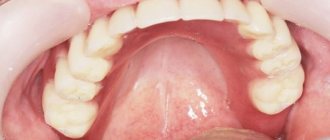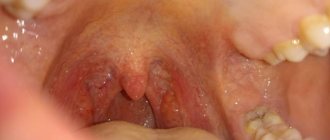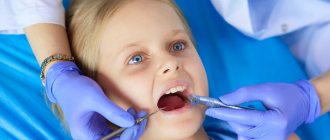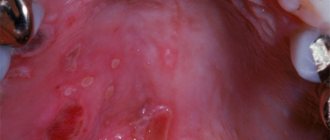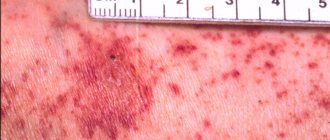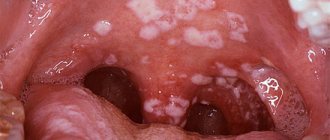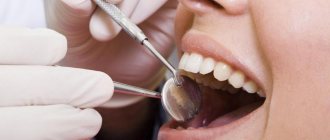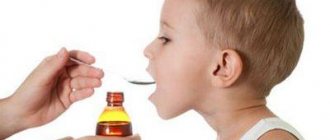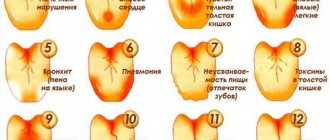When performing daily hygiene procedures for cleaning the oral cavity, you should carefully examine the mucous membrane of the palate and tongue.
Identified red spots, plaque and yellowness indicate problems that have arisen in the body. It is easier to prevent the development of any disease if you seek help from a doctor as early as possible.
Causes
The palate area, like other areas of the skin and mucous membranes, is characterized by a strong blood supply, which is due to the presence of a dense network of capillaries.
The normal color formed on the surface indicates the absence of an inflammatory process in the body and other serious disorders. A change in the color of the palate is a manifestation of the symptoms of the disease, which is determined after the study.
The reasons that provoke the formation of yellowness can be found in the table:
| Reasons for the formation of yellow plaque on the palate | ||
| Reason name | Description | Additional symptoms |
| Liver diseases | The most common liver diseases, recognized by the yellowness of the palate, are: jaundice, cirrhosis, cholecystitis, cholelithiasis and syphilis. When an organ is damaged, disruptions in the functioning of all systems and metabolic processes occur: protein, carbohydrate, fat, pigment, etc. Depending on the disease, the corners of the palate and the boundaries between soft and hard tissue (with cholecystitis, bile stones) or the entire surface of the mucous membrane turn yellow. (for hepatitis). |
|
| Pancreas problems | The organ regulates energy exchange and biochemical processes occurring in the human body. If there are problems with the pancreas, one of the main signs appears - the soft palate acquires a bronze tone. If malfunctions occur in the biliary system, the color is combined with pronounced jaundice. |
|
| Intestinal inflammation (large/small) | Yellowness on the upper palate with intestinal dysfunction appears due to the morphofunctional unity of the oral mucosa and the gastrointestinal tract. The color of the palate changes to yellowish both in individual zones and over its entire surface. The neglect of the disease is reflected in the intensity and structure of plaque. |
|
| Kidney failure | The main provocateurs of renal failure: urolithiasis, diabetes mellitus, pyelonephritis, neoplasms, lipid metabolism disorders. As a result of a failure of metabolic and biochemical processes, yellowness appears on the hard palate. Additional symptoms help determine whether the kidneys are involved in the problem. |
|
| Cholesterol and fat metabolism disorders | Cholesterol metabolism disorders are accompanied by a change in the color of the soft palate from pink to yellow. At the same time, gray lumpy spots are clearly visible on the surface of the mucosa. Failures in fat metabolism are recognized by a pale icteric coating on the palate. The main provocateurs of metabolic disorders are: tuberculosis, diabetes, oncology. |
|
| Smoking | The color of the palate changes under the influence of resins, which are included in tobacco in high concentrations. A bad habit provokes disruption of blood circulation and biochemical processes in tissues associated with disruption of metabolic and other processes. The mucous membrane loses its pink color and becomes yellow. |
|
Diagram of the oral cavity
Why does pain occur?
Painful sensations can be disturbing for many reasons: pathological processes occurring inside, infectious lesions, functional disorders. There are cases when pain is caused by high tissue sensitivity, due to cold or hot food, or poor cleaning of the oral cavity. The mouth is an ideal environment for bacteria to multiply, so even a minor irritation or sore can develop into more serious problems.
According to dentists, there are ten main reasons that cause pain in the roof of the mouth.
- Infection caused by bacteria. The palate becomes filled with blood, swelling and a dirty gray coating appears, and ulcers cause discomfort.
- Inflammation of the tonsils, sore throat. Often the symptoms are the same as in the first case. If the disease is neglected, complications related to the heart and joints are possible.
- Stomatitis. The disease is characterized by a yellow coating, pain when chewing, possibly increased salivation, and painful ulcers.
- Leukoplakia is a pathological condition of the oral cavity that occurs due to eating food with a contrasting temperature. It is caused by injuries to the mucous membrane. It is considered to be a pre-cancer condition.
- Smoking. During smoking, the mucous tissues of the oral cavity suffer from the increased temperature of inhaled smoke and its components. Tappeiner's leukoplakia is a common occurrence in smokers.
- The salivary glands become inflamed as a result of infectious components entering the oral cavity. In this case, the submandibular, sublingual and minor glands responsible for salivation are affected.
- Neuralgia, pathological conditions of the joints. Soreness is usually felt in the teeth, gum tissue, and face.
- Sialometaplasia is a benign neoplasm that occurs in the tissues of the oral cavity. A pain syndrome occurs, when a certain size is reached, the tumor spontaneously bursts, and an ulcer forms in its place.
- Unsatisfactory performance of treatment or tooth extraction, careless placement of a prosthesis for the patient.
- Chemical and thermal burns caused by inattention.
Yellow palate in the mouth of an adult
In people over 50 years of age, the appearance of a yellow coating on the palate is considered a physiological process
If the sky has turned yellow, you should see a dentist. During the examination, the specialist will determine whether the yellowness of the mucous membrane is a sign of any disease, or indicates a lack of proper oral hygiene.
The patient’s attitude towards bad habits is also taken into account. Yellowness with a pronounced network of veins is often formed as a result of regular smoking.
When conducting diagnostics, the patient's age is taken into account. In people over 50 years of age, the appearance of yellow plaque on the palate is considered a physiological process, so serious health problems are not always detected.
The child has
A yellowed sky appears not only in adults, but also in children. In addition to dental problems, this sign may indicate other diseases, so the child should be shown to a gastroenterologist, ENT specialist, pediatrician, infectious disease specialist, or hepatologist.
Often, young patients with this symptom are diagnosed with thrush. If there is any doubt in determining the problem, it is recommended to undergo a full examination, including donating blood to check bilirubin levels.
Diagnostics
Based on the visual examination, the doctor plans further diagnostics.
The initial examination should be entrusted to the dentist; problems with the oral cavity are within his competence. The specialist studies not only the oral mucosa, but also the condition of the gums, teeth and the gaps between them.
This is where signs of thrush or stomatitis may appear. Based on the visual examination, the doctor outlines the following stages of diagnosis.
Changed color of the palate may be an independent condition or indicate the development of other diseases.
To clarify the diagnosis, the dentist refers the patient to the following specialists:
- otolaryngologist;
- therapist;
- oncologist;
- allergist.
Diagnostics also includes laboratory tests of biological samples: blood, urine, feces.
If an allergy is suspected, the patient is referred to undergo:
- Ultrasound;
- CT;
- MRI;
- x-ray.
The doctor examines the oral cavity
How to prevent diseases of the palate?
There are many reasons for pain in the palate. It is within human power to prevent burns, infections, and injuries.
It is important to follow these rules:
- the temperature of the food should not be very high or low;
- Before eating vegetables and fruits, it is important to wash them thoroughly;
- visiting the dentist should be systematic - teeth treated on time will not cause problems with the palate;
- reduce the consumption of solid foods to avoid trauma to the mucous membranes;
- Oral hygiene should be done every morning and evening;
- taking multivitamins helps strengthen the immune system, which increases the resistance of mucous membranes to infections;
- parents should talk with children about the rules of oral hygiene, explain why certain objects should not be allowed to get into the mouth;
- It is necessary to exclude contact of dirty hands with the mouth, stop biting your nails, and make it a rule to wash your hands after every trip to the toilet.
Important ! Pain in the mouth is an alarming signal that requires immediate medical attention!
In order to prevent infection, it is important to change your toothbrush after treatment of dental diseases (stomatitis) or after dental prosthetics.
Stomatitis provokes increased salivation, so during the period of illness you should increase the amount of water consumption.
Treatment
Signs of pharyngitis
The results of the patient's studies indicate a problem existing in the body.
A specialist with a narrow profile will be able to prescribe treatment: nephrologist, gastroenterologist, urologist.
If signs of a systemic disease are detected (syphilis, rheumatism, HIV, etc.), a referral is given to the hospital of a specialized medical institution.
When oncology is detected, a treatment regimen is developed jointly with other specialists: a surgeon, oncologist, neurologist, ophthalmologist, etc.
Diagnosing a local viral infection on the oral mucosa involves prescribing antiseptics and antibiotics to suppress the inflammatory process and destroy the pathogen. The same drugs are used to treat periodontitis, gingivitis and in cases where it is necessary to prevent ulcerative-necrotic complications.
Whatever treatment method is chosen, the doctor also prescribes oral hygiene procedures:
- professional cleaning;
- selection of products for daily hygiene of the dentition and oral mucosa;
- regular rinsing with an antiseptic solution.
An equally important step is strengthening the body’s protective functions. For these purposes, regular intake of vitamin complexes is suitable, which promptly replenish the deficiency of essential vitamins and minerals.
Traditional methods
To remove yellow plaque from the palate, local treatment with various infusions and their internal use are recommended.
In folk medicine, mainly components of plant origin are used, which have anti-inflammatory, antiseptic and other effects.
To remove yellow plaque from the palate, local treatment with various infusions and internal use of infusions and products to strengthen the body's protective functions are recommended.
Eg:
- infusions and teas from marshmallow root, St. John's wort, licorice, and chamomile provide an excellent antiseptic effect;
- rinsing the mouth with a decoction of sage, calendula, and yarrow has an antibacterial effect;
- consuming bee products and citrus fruits strengthens the immune system.
The traditional medicine methods used must complement the general principles of treatment recommended by the doctor, but in no case should they contradict official requirements.
It is also worth considering that infusions, decoctions and teas have an enhancing effect of traditional therapy, but they cannot replace drugs and procedures.
Preventive measures
As a preventive measure, after eating you need to rinse your mouth with a special balm or at least clean water.
As a preventative measure, it is recommended to periodically undergo dental examinations.
This will help identify the disease at an early stage and begin a course of treatment in a timely manner, thereby preventing the development of complications.
It is also necessary to carry out daily oral hygiene procedures to remove food debris and remove plaque from the mucous membrane.
The main defense of any person is, first of all, immunity. To strengthen it, you should maintain physical fitness, radically review your diet, and enrich the body with valuable minerals and vitamins.
The following recommendations are also preventive measures:
- You should not overuse spicy, salty foods, or foods with a hard structure;
- after eating, you need to rinse your mouth with a special balm or at least clean water;
- If you experience unpleasant sensations in your mouth, rinse for several days using decoctions of propolis, chamomile, oak bark or sage.
Quitting bad habits, in particular smoking, can prevent the formation of yellow plaque on the palate.
Traditional medicine for pain in the palate
Pain in the palate causes discomfort and interferes with the usual way of life. Infusions from decoctions of medicinal herbs will help reduce pain, relieve swelling and alleviate the general condition.
| Name | Description |
| Onion peel decoction | For 3 tablespoons of chopped onion peel you will need half a liter of water. The composition is brought to a boil, then put in a dark place for 8 hours. Before rinsing, the broth should be strained and used 2-3 times a day. |
| Horse sorrel solution | Horse sorrel roots need to be chopped. For a glass of boiling water you will need one tablespoon. The solution is brought to a boil over heat and boiled for 15 minutes, filter and rinse the mouth. |
| nettle leaves | Finely chopped nettle leaves in the amount of 1 tablespoon are poured into two glasses of boiled water. You need to let the product sit for half an hour and strain. Such rinses help if ulcers on the mucous membrane do not heal well. |
| Collection of herbs | Ingredients required for preparing the infusion: sage - 1 glass; calendula flowers - 1 cup; 1.5 glasses of water. Place finely chopped herbs in an enamel bowl and fill the contents with water. After thorough mixing, the pan should be placed in a water bath. Boil the infusion covered for about 10 minutes, then cool and strain. The solution is ready for rinsing. They need to be done several times a day. |
There are many other simple recipes to relieve pain.
- Combine 1 teaspoon of onion juice with 1 teaspoon of Kalanchoe juice and 3 tablespoons of water. After mixing, rinse your mouth for 1-3 minutes.
- A decoction of plantain will help eliminate ulcers. To prepare, grind 2 tablespoons of herbs, pour two glasses of boiling water over them and leave. Strain before rinsing; the broth should be warm.
